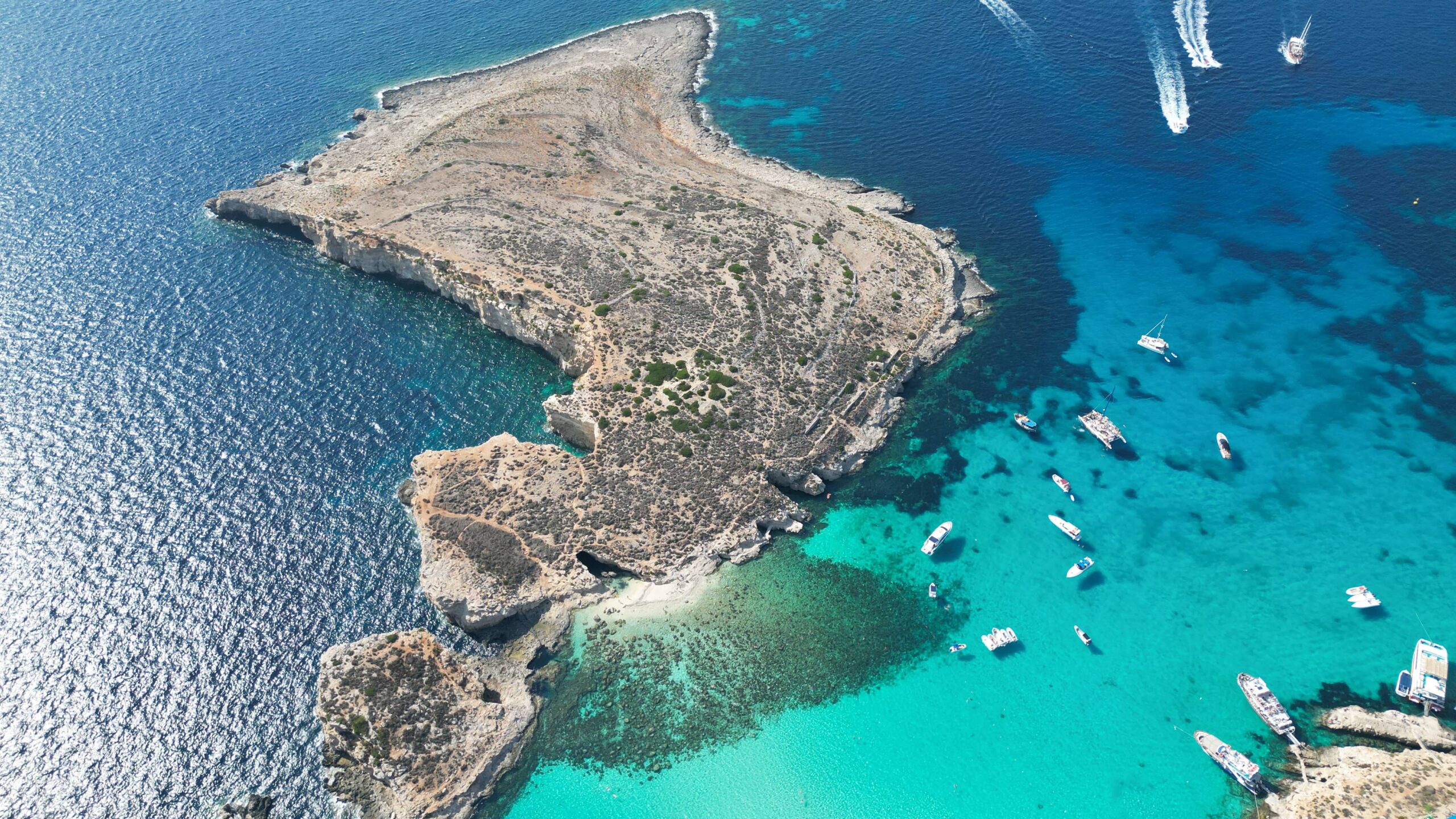Comino and Cominotto Malta’s Most Mysterious Islands
Some islands feel like they’re hiding something — like their cliffs, caves, and coastlines have held onto stories for centuries. Comino and Cominotto are exactly that kind of place. Floating between Malta and Gozo, these two small islands are wrapped in legends, silence, and a kind of wild beauty that’s becoming harder to find in today’s world.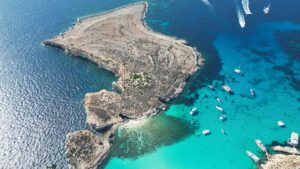
You’ve probably heard of the Blue Lagoon — a turquoise bay that’s famous around the world — but how much do you really know about the land around it? Beyond the tourist boats and the surface-level beauty lies a deep and fascinating history, a rugged landscape shaped by nature and conflict, and quiet bays like San Niklaw Bay and Santa Marija Bay that tell a different story — one of solitude, survival, and simplicity.
Let’s step back in time and walk the coastline of Comino and Cominotto, uncovering the true character of Malta’s most mysterious islands.
Where Time Stands Still: Introducing Comino and Cominotto
Between Malta and Gozo, Yet a World Away
Comino sits quietly between the two main islands of Malta and Gozo, almost unnoticed unless you know what to look for. With an area of just 2.8 square kilometers, it’s the third smallest island in the Maltese archipelago — and yet, it holds a larger-than-life presence thanks to its dramatic coastline, hidden coves, and long, layered history.
Just 125 meters to the west, you’ll find Cominotto — smaller still, with a landmass of about 0.25 square kilometers. Despite its size, Cominotto plays a big role in shaping the natural beauty of the famous Blue Lagoon Malta, which lies between the two islands like a natural pool carved from the sea.
A Rugged Coastline Carved by Nature
The coastline of Comino stretches over 9.5 kilometers and is wildly diverse — with soaring cliffs on the eastern side, sandy inlets in the north, and a maze of sea caves scattered around the perimeter. The island is made of upper coralline limestone, and over the centuries, wind and water have shaped it into something raw and untamed.
It’s this very coastline that once gave shelter to pirates and smugglers, and now attracts kayakers, snorkelers, and private charter boats looking to escape the crowds and discover Comino’s quieter corners. Some caves are accessible only by water, making them ideal for those exploring by boat or jetski.
San Niklaw Bay and Santa Marija Bay: Quiet, Underrated, and Full of Character
Away from the buzz of the Blue Lagoon, San Niklaw Bay and Santa Marija Bay offer something rare — peace. These small bays on the northern side of Comino are less visited and often missed by large tour operators, making them perfect for those in search of a tranquil escape.
San Niklaw Bay is a charming cove with a sandy beach, calm waters, and natural surroundings. It’s also where the original Comino Hotel was built in the 1960s. Although now closed, the area remains a peaceful landing spot for private boat charters and day visitors seeking space and quiet.

santa marija comino bay
just a short walk away, is even more serene. It’s one of the few places on the island where you can still feel like you have the beach to yourself — especially outside of peak season. The Santa Marija Chapel, with roots stretching back to the 13th century, stands nearby as a reminder that Comino has always been more than just a pretty place — it’s been a spiritual and cultural refuge for centuries.
Layers Beneath the Surface: Comino’s Ancient Past
Comino may be quiet today, but beneath its rocky soil lies a timeline that stretches back over two thousand years. This tiny island, often dismissed as just a beach stop, has quietly preserved traces of ancient life — the kind of discoveries that help piece together Malta’s earliest history.
Phoenicians, Romans, and the Earliest Settlers
The first clues of Comino’s ancient significance came in 1630, when the Maltese historian Giovanni Francesco Abela recorded the discovery of lead amphorae and earthenware pipes on the island. These containers were likely used to store and transport water, hinting that Comino wasn’t just a stopover — it was once a point of human activity, possibly even settlement.
Ten years later, in 1640, an earthenware sarcophagus was discovered in Wied Ernu. Experts believe it belonged to a Phoenician settler, suggesting that Comino was known and used by seafaring cultures long before medieval times.
One of the most remarkable finds happened in 1912, when workers digging near Qala Santa Marija unearthed a large earthen jar. Inside, archaeologists found the skeleton of a man from the 3rd century BC, carefully placed between two halves of an amphora, along with oil lamps and ointment phials. These artifacts are now housed in the Archaeological Museum at the Cittadella in Gozo — a silent testimony to Comino’s early role in Mediterranean life.
A Name for Every Age
Comino has had many names throughout history — each one a reflection of the language, culture, or empire that passed through. The ancient Greek navigator Scillace referred to it as Lampas, meaning “meteoric.” Later, Ptolemy listed it as Chemmona, while Cluverius used Hephaestia, a reference to volcanic origins.
When the Arabs arrived, the island became known as Kemmuna, a name likely inspired by the wild cumin plant (kemmun) that once grew in abundance here. In Greek, the word Kineni means “adjacent” — fitting, since Comino is the closest island to Malta.
These names tell us something important: Comino was never completely forgotten. For thousands of years, it has been marked on maps, referenced in books, and walked upon by sailors, soldiers, farmers, and mystics.
The Mystery of Cominotto
Though much smaller, Cominotto may also have played a role in the ancient world. Its proximity to Comino and the naturally shallow seabed that once connected them made it a natural part of early coastal navigation. Over time, storms — particularly one recorded in 1957 — deepened the channel between the two islands, but their historical and geological connection remains clear.
Fortress Island: Pirates, Knights, and the Tower
For a long stretch of its history, Comino wasn’t just a peaceful retreat — it was a battleground for control, power, and survival. Thanks to its position between Malta and Gozo, the island held immense strategic value for traders, pirates, and rulers alike. And for many years, it was both a target and a stronghold.
Pirates and Predators of the Sea
During the medieval period and beyond, the Mediterranean was plagued by piracy, and Comino, with its hidden coves and quiet bays, became a natural hideout for corsairs. These pirates used Comino’s caves and inlets as ambush points, attacking ships crossing the Gozo Channel and retreating into the island’s folds before retaliation could come.
The threat was serious. Sea travel between Malta and Gozo became so dangerous that merchants and travelers often avoided it altogether. For years, Comino was left in the hands of pirates, who used its geography to their advantage.
The Tower That Changed Everything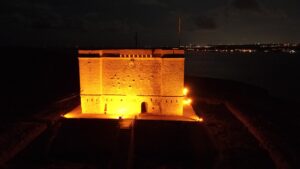
To break this cycle of lawlessness, the Knights of St John took action. In 1618, Grand Master Alof de Wignacourt proposed a plan to build a defensive tower on Comino — one that would protect the channel and keep watch over the waters day and night.
Construction of the Santa Marija Tower began soon after and was completed in 1620. Built from limestone on a high bluff overlooking the sea, the tower was square in shape, 40 feet tall, and fortified with four corner turrets and walls over five meters thick. It also had a deep plinth base and a drawbridge-style entrance, giving it a fortress-like presence that could not be ignored.
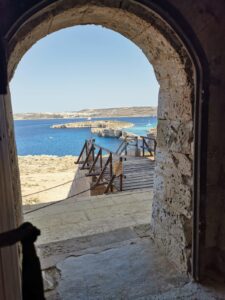 For the first time, Comino had a real defender. The tower was manned by guards, armed with cannons, and became a key part of Malta’s island-wide defense system. It worked in tandem with Garzes Tower in Gozo, forming a watchful pair that could signal incoming attacks.
For the first time, Comino had a real defender. The tower was manned by guards, armed with cannons, and became a key part of Malta’s island-wide defense system. It worked in tandem with Garzes Tower in Gozo, forming a watchful pair that could signal incoming attacks.
Punishment, Protection, and the Changing Role of the Tower
As years passed, the Santa Marija Tower became more than just a lookout post. It was used to punish unruly knights, who were sent to live in exile on Comino as a form of discipline. Later, during the 18th and 19th centuries, the tower helped enforce quarantine laws and anti-smuggling efforts, keeping disease and illegal goods from spreading between the islands.
During World War I, the tower took on yet another role — housing German prisoners of war. These prisoners were allowed to farm the land, craft basic tools, and even experiment with small inventions, including a rat-powered water mill built by one particularly creative detainee.
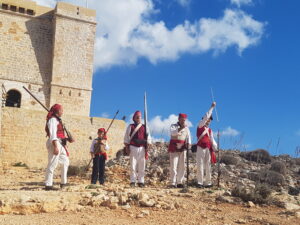
comino tower reenactment
In 1982, the Armed Forces of Malta took over the tower again for surveillance purposes, continuing to use it until 2001. By then, the structure had suffered years of weathering, but a major restoration project funded by the Malta Maritime Authority and Din l-Art Ħelwa brought it back to life. Today, the Santa Marija Tower is one of the most iconic structures on the island — and one of the most photographed landmarks in all of Comino.
Faith, Mysticism, and Isolation: The Spiritual Side of Comino
While Comino is often associated with sea, sand, and solitude, it has also been a place of spiritual retreat, reflection, and deep religious significance. Long before tourism reached its shores, Comino drew in hermits, monks, and mystics searching for silence and meaning. For centuries, faith was the island’s beating heart.
The Chapel of Santa Marija: A Beacon of Devotion
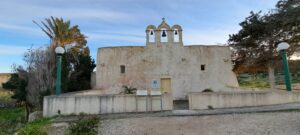
Santa Marija Chapple
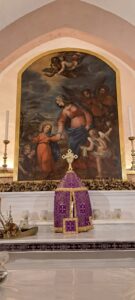
Comino Chapple altar
Tucked inland from Santa Marija Bay, the Chapel of the Return of Our Lady from Egypt — often simply called the Santa Marija Chapel — has been a spiritual landmark on the island for hundreds of years. It stands on the same site as a much older medieval chapel, which appears in the 13th-century navigation chart Lo Compasso de Navegare. That reference alone suggests that the original chapel existed before the year 1250, making it one of the oldest continuous places of worship in the Maltese islands.
The present chapel has a quaint stone façade, a triple-arched belfry, and a wooden screen separating the altar from the nave. Inside, you’ll find statues of the Sacred Heart of Jesus, the Sacred Heart of Mary, and Saint Joseph, along with a titular painting restored in 1928 by the renowned Vincenzo Bonello.
Today, this humble church continues to host mass — especially in summer — and remains a symbol of Comino’s religious roots and quiet resilience.
Abulafia the Mystic: A Hidden Chapter in Comino’s Story
One of the most fascinating spiritual chapters in Comino’s past comes from the life of Abraham ben Samuel Abulafia, a Spanish-born Jewish mystic, philosopher, and Kabbalist. After being expelled from several cities for his controversial teachings — and even attempting to convert a pope — Abulafia arrived on Comino around 1285, where he lived in seclusion for several years.
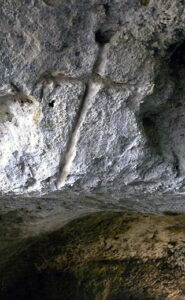
Hermit Cave
It was here, surrounded by the solitude of sea and sky, that he penned parts of his spiritual masterpiece Sefer ha-Ot (The Book of the Sign). Abulafia preached unity of all faiths and believed in the mystical connection between language, sound, and divine presence. He called himself the Messiah and left behind teachings that would influence Kabbalistic thought for generations.
That such a figure chose Comino for solitude and divine contemplation speaks volumes about the energy of the place — a space removed from time, distractions, and noise.
A Sanctuary for Hermits and the Faithful
Throughout the centuries, Comino also served as a hermit’s retreat. In the 15th century, a holy man named Kerrew — who lived across the channel in Hondoq ir-Rummien, Qala — would frequently visit a fellow hermit on Comino for prayer and conversation. Their paths remind us that while Comino may seem isolated, it has always been spiritually connected to its neighbors and wider religious currents.
Later, in the 18th and 19th centuries, chaplains were assigned to the island not just to say mass, but also to act as teachers, welfare officers, and spiritual guides to the few residents. They lived in a small house in “The Palace” — a building originally built during the rule of Grand Master Wignacourt — and travelled the island by foot or in old jeeps along dirt roads.
Even today, the chapel and its traditions live on. The titular feast of the Sacred Heart of Jesus is celebrated every July, and it’s common for the Bishop of Gozo to visit and conduct mass, bringing together locals, summer visitors, and faithful from nearby villages.
A Changing Landscape: From Farms to Forgotten
Comino’s story didn’t stop with knights and mystics. In fact, the most dramatic transformation happened in the last 150 years — when the island went from a military post to a rural outpost, and eventually to an experimental hub for agriculture and tourism. This was a time when families worked the land, children played under the Mediterranean sun, and boats brought bread instead of cannonballs.
Farming in Isolation: A Tough but Hopeful Life
By the late 1800s, a few families had settled on Comino in search of farming opportunities. Drawn from nearby villages like Mellieħa, St Paul’s Bay, and Gozo, they built modest farmhouses, raised livestock, and cultivated crops such as onions and potatoes, which were even exported to cities like Glasgow.
One of the best-known families was the Salvus family, descendants of early settlers who remain connected to the island to this day. In fact, Salvu
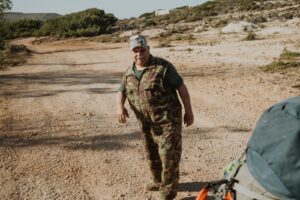
Comino Salvu
, one of the last full-time residents of Comino, is often seen maintaining what’s left of the old community spirit. His quiet presence keeps alive the legacy of a time when 65 workers lived and worked full-time on the island.
A bakery was set up to serve the whole island, and bread was baked once a week by Mary Said, a beloved figure among the workers. Water was pumped from ancient reservoirs in Wied l-Aħmar, and basic healthcare was provided by visiting chemists and roaming priests who also doubled as teachers and social workers.
It wasn’t an easy life — the isolation was intense, the roads were little more than tracks, and farming in the rocky soil was a challenge — but there was a strong sense of community.
The Rise of Tourism: Hotels, Bungalows, and Big Promises
In the 1960s, the colonial government saw Comino’s potential as a tourist destination. A 150-year lease was granted to Comino Development Co. Ltd., which aimed to build a tourist resort complete with a hotel, restaurant, and self-catering bungalows.
The Comino Hotel was built in San Niklaw Bay, and later, bungalows and a beach club were added near Santa Marija Bay. This marked the beginning of the island’s modern reputation as a summer escape. For a time, Comino thrived again — not with fields and fruit trees, but with sun loungers and cocktails.
In the 1970s and 80s, the hotel even hosted the Club Nautico, a gathering place for visitors, sailors, and expats. Swiss investors took over operations, and the bay echoed with the sounds of clinking glasses, children playing in the sea, and the soft thump of music from beach parties.
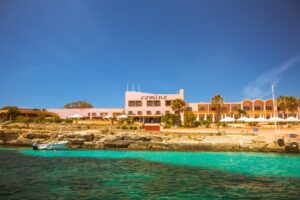
Comino Hotel
But Comino’s magic couldn’t be fully tamed. Logistics were difficult, weather often disrupted ferry service, and political changes in Malta led to disagreements over the land’s use. Over time, the resort changed hands, and eventually, operations slowed. By the early 2000s, the hotel and bungalows had fallen into disrepair — a shadow of their former self.
The Comino Hotel officially closed its doors in 2018, and as of now, remains shut to the public. However, it is widely believed that plans are underway to replace it with a larger, modern resort designed to better align with the island’s natural environment and tourism potential. This proposed redevelopment has sparked both interest and concern, especially among those passionate about preserving Comino’s unique character and untouched charm.
From Pig Farms to Conservation Zones
In the late 1970s, Comino became the site of an agricultural project focused on breeding disease-free pigs. With help from the FAO and EEC, the Maltese government built a series of pig farms in the interior of the island. These were heavily guarded and required special permits to access. Over the years, the program helped restock Malta and Gozo’s pig farms with healthy swine, but the project was eventually shut down in the 1990s.
Today, most of those farm buildings are abandoned. Some are reclaimed by nature. Others serve as quiet reminders that Comino has been a place of experiments, resilience, and reinvention.
Cominotto: Small Island, Big Stories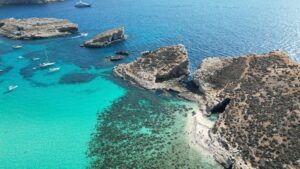
If Comino is often misunderstood, Cominotto is almost invisible — a quiet, uninhabited islet just 125 meters off Comino’s western shore. But don’t be fooled by its size. This miniature island, sometimes called Kemmunett by locals, is one of the key reasons the Blue Lagoon is so iconic.
Sheltered by both Comino and Cominotto, the Blue Lagoon forms a natural pool of shallow, turquoise water with a white sandy seabed — perfect for swimming, snorkeling, and anchoring small boats. Without Cominotto, the lagoon wouldn’t exist as we know it. The two islands create a barrier from open sea, protecting the water from waves and currents and giving it that calm, clear look that’s now world-famous.
A Changing Seabed and a Hidden History
Few people know that the stretch of sea between Comino and Cominotto used to be much shallower than it is today. In fact, up until the mid-1900s, the channel was so shallow that it was often possible to walk or wade across, especially during calm weather.
That changed dramatically after a powerful storm struck the islands in January 1957. Heavy seas washed away much of the soft seabed between the two islands, pushing sand out into deeper water and deepening the channel permanently. Since then, the Blue Lagoon has become more navigable, especially for smaller charter boats and pleasure craft — but the original shallow seabed is part of what made the area so unique in earlier times.

comino blue lagoon
A Place of Storage, Secrecy, and Strategy
In earlier centuries, Cominotto was used for storage and customs-related operations. The old Custom House near the lagoon once functioned as a checkpoint for goods moving through the channel, and there are accounts of gunpowder being stored on Cominotto in times of military tension.
Before World War II, British Petroleum is believed to have stored fuel drums on the island as part of a strategic reserve. Its isolation made it a convenient spot for keeping supplies hidden and secure — a kind of natural offshore warehouse. Today, those stories have mostly faded, but the quiet strength of the island remains.
Nature’s Untouched Outpost
Today, Cominotto is completely uninhabited and protected by nature conservation laws. Its rocky surface is home to nesting birds, endemic plants, and even lizards that differ slightly in color from those on Comino, Malta, or Gozo. It may not have buildings or paths, but Cominotto plays a vital role in the local ecosystem — and in the experience of every visitor who swims, dives, or sails through the Blue Lagoon.
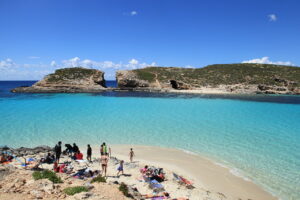
Cominotto island, comino beach
While most tourists never set foot on Cominotto, its outline features in every photo of the Blue Lagoon, and its presence helps define the lagoon’s shape and stillness. It’s a reminder that even the smallest islands can leave the biggest impressions.
San Niklaw Bay and Santa Marija Bay: Forgotten Corners of Paradise
While most visitors head straight to the Blue Lagoon, those who take the time to explore the northern edge of Comino often stumble upon two of the island’s best-kept secrets: San Niklaw Bay and Santa Marija Bay. These tranquil coves offer more than just a place to swim — they offer a window into Comino’s soul.
San Niklaw Bay: Where Comino’s Modern Story Began

Comino Hotel
San Niklaw Bay lies on the northeast side of Comino and is known for its calm, clear waters and sandy seabed. Sheltered from the wind and less exposed than other parts of the island, it’s an ideal spot for swimming, paddleboarding, or simply unwinding in the sun.
But San Niklaw Bay isn’t just a pretty beach — it’s also the birthplace of modern tourism on Comino. In the 1960s, this bay was chosen as the site of the original Comino Hotel, a low-rise resort designed to bring comfort and hospitality to one of Malta’s most remote islands. The hotel once welcomed guests from across Europe and became a symbol of Comino’s transition from a sleepy outpost to a holiday escape.
Though the hotel is currently closed, San Niklaw Bay retains its charm. Today, it serves as a quiet mooring point for private boat charters and an excellent place to take a peaceful dip, especially in the early morning or late afternoon when the sea is calmest.
Santa Marija Bay: Silence, Simplicity, and Spiritual Roots
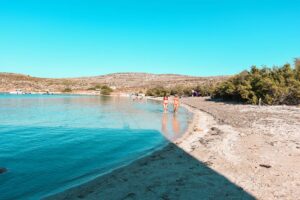
Santa Marija Bay
Just a short walk or boat ride away lies Santa Marija Bay, perhaps the most tranquil corner of Comino. Framed by low cliffs and soft hills, the bay has a small stretch of sandy beach backed by trees and coastal vegetation. The sea here is typically flat and glassy, with gentle slopes that make it perfect for families with young children.
Beyond the beach, this area is deeply connected to Comino’s cultural and religious past. The nearby Santa Marija Chapel, with its medieval roots and quiet presence, reminds visitors that this island was once more than a getaway — it was a spiritual refuge, a place where faith and nature lived side by side.
There’s also a small police station, a reminder of the bay’s functional role in modern times. Officers based here help monitor marine activity, protect wildlife, and assist in emergencies. Despite its seclusion, Santa Marija Bay is a working part of the island, and it’s this blend of peace and purpose that gives the area its unique energy.
Peace Without the Crowds
Unlike the Blue Lagoon, these two bays remain relatively uncrowded, especially outside of peak season. Many visitors on private charters or jetski tours choose to stop here for a break from the crowds — to swim, snorkel, or just enjoy the quiet. You won’t find kiosks, loudspeakers, or rows of umbrellas — just raw, natural beauty and the gentle rhythm of the sea.
For photographers, these bays offer some of the best light on the island, especially during golden hour. For swimmers, they offer space and clarity. And for anyone seeking a real connection to Comino, they offer something the Blue Lagoon rarely can — a moment of true stillness.
A Natural Haven Under Threat
Despite its rugged beauty and remote charm, Comino is under pressure. As one of the most photographed destinations in Malta, the island now receives tens of thousands of visitors every year — far more than it was ever meant to handle. While the attention may bring short-term economic gains, the long-term impact on Comino’s delicate ecosystems is a growing concern.
A Sanctuary for Wildlife
Comino is more than beaches and cliffs. It’s a designated bird sanctuary, a protected area for migrating species, and one of the few places in Malta where wildlife can thrive without constant human interference. The garigue landscape, with its low, wind-shaped shrubs and aromatic plants, supports a range of rare and endemic species, including lizards, butterflies, and land snails found nowhere else in the world.
In Santa Marija Bay, it’s common to spot hedgehogs and wild rabbits — species that have lived quietly on the island for decades. And in recent years, Comino has been declared a nature reserve for hunting purposes, allowing bird populations to begin recovering during critical migration seasons.
Cominotto’s Quiet Contribution
Across the water, Cominotto also plays its part. Though uninhabited, it’s home to distinct flora and fauna, including lizards with slightly different coloring than their counterparts on Malta and Gozo. The surrounding waters are alive with marine species, including octopus, sea bream, and parrotfish. The islet may look barren, but it’s a vital part of the Blue Lagoon’s ecological balance.
Tourism and Environmental Stress
As Comino gained popularity, the island’s natural systems began to strain under the weight of mass tourism. During the peak summer months, thousands of visitors arrive daily via commercial ferries. The narrow paths and tiny beaches become overwhelmed, rubbish builds up quickly, and the once-crystal-clear shallow waters are exposed to noise, fuel spills, and heavy overcrowding.
Old infrastructure can’t keep up. Litter bins overflow, trails are worn down, and generators rumble in the background. The peacefulness that once defined Comino has, in some areas, been replaced by engine noise, loudspeakers, and constant foot traffic.
Recognising this growing problem, the government’s 2025 plan aims to reduce the number of commercial boat passengers to Comino by half. This includes limiting visitor numbers, establishing new designated swimming zones, and introducing a ticketing system for those stepping onto land in the Blue Lagoon. It’s a clear effort to strike a balance — to allow access while restoring the natural harmony.
However, safeguarding Comino’s future requires more than just restrictions. It’s also about rethinking how tourism works on the island.
Since most people who visit Comino come to experience the Blue Lagoon, we need to reimagine how that experience is delivered without harming the environment. A sustainable model might include staggered visitor times, smaller groups, and a greater push toward private boat charters that follow responsible practices and avoid crowding sensitive areas.
Additional steps must be taken to reduce Comino’s ecological footprint:
-
Strict enforcement of a no-fishing zone within the Blue Lagoon and Comino as a whole, would help protect fragile marine ecosystems already under pressure from foot traffic, anchor drops, and snorkelers.
-
Rubbish collection should occur multiple times a day, with waste shipped to Malta or Gozo.
-
Single-use plastics, including packaging and straws, should be phased out completely. Offering reusable or biodegradable alternatives would dramatically cut down on pollution.
-
-
Kiosks could be connected to a central electric system, eliminating the constant hum and emissions from petrol-powered generators. This single move would reduce both noise pollution and air pollution, making the bays quieter and cleaner for all.
These are not radical ideas — they’re practical, achievable steps that could help preserve Comino’s beauty while still giving locals and visitors the chance to enjoy it.
Ultimately, protecting Comino doesn’t mean closing it off — it means choosing smarter ways to enjoy it, where future generations can still marvel at its wild, peaceful charm.
-
Conservation in Action
Groups like Din l-Art Ħelwa and the Malta Maritime Authority have played major roles in protecting Comino’s heritage. From restoring the Santa Marija Tower to reinforcing the old battery walls, their work ensures that both natural and cultural landmarks are preserved for future generations.
Recently, plans for a new hotel development on the island have raised fresh concerns about environmental impact. While the current Comino Hotel remains closed, many are watching closely to ensure any future project respects the land’s fragility and unique ecological value.
Preserving the Past, Protecting the Future
For a place so small, Comino holds a deep legacy — not just in its caves, towers, and chapels, but in the lives of those who once lived here, and the quiet stories still echoed by the sea breeze. As modern pressures mount, there’s a growing movement to protect what’s left — not only from overdevelopment, but from being forgotten altogether.
Restoring the Island’s Landmarks
Over the past two decades, groups like Din l-Art Ħelwa (National Trust of Malta) have taken a lead role in restoring Comino’s historical treasures. The most notable example is the Santa Marija Tower, which had suffered severe weathering, vandalism, and neglect. Starting in 2001, a full-scale restoration project rebuilt missing stones, repaired the crumbling battlements, and gave new life to one of Malta’s most important coastal defenses.
The nearby Santa Marija Battery, originally built in 1715 to guard the Comino-Gozo channel, has also been carefully repaired. Repointing the stonework, securing crumbling embrasures, and re-mounting its historic cannons turned what was once an abandoned ruin into a respected cultural site once again.
These projects are more than cosmetic — they’re about protecting a unique chapter of Malta’s story, one that played out quietly on an island most people only visit for a swim.
Cultural and Natural Heritage Side by Side
Preserving Comino isn’t just about ancient buildings — it’s about protecting the landscape that shaped them. The island’s cliffs, valleys, caves, and garigue form a living museum, where nature and history sit side by side. And it’s this harmony — of land, sea, and story — that makes Comino irreplaceable.
Places like San Niklaw Bay and Santa Marija Bay are more than just pretty coves; they’re reminders of a simpler Malta, before mass tourism and mega-developments. They speak of small communities, spiritual solitude, and an island that never tried to be more than it was — and never needed to.
A Call for Respectful Tourism
Today, the responsibility to protect Comino for future generations doesn’t just fall on the government — it falls on all of us. Travelers can help by choosing eco-friendly experiences, reducing waste, respecting restricted zones, and exploring the island with curiosity instead of consumption.
Comino doesn’t need to be built up or transformed. It needs to be understood, respected, and explored gently. Whether you come for the history, the nature, or simply the silence, your visit can be part of the solution — a way to experience one of Malta’s most treasured places without leaving a mark.
How to Visit Comino Respectfully (And Why Private Charters Are the Smartest Way to Do It)
Comino is special — and like all special places, it deserves to be visited with care. Whether you’re drawn by the crystal waters of the Blue Lagoon, the serenity of San Niklaw Bay, the mystery of Cominotto, or the wild paths near Santa Marija Bay, your experience can be just as memorable without contributing to overcrowding or environmental harm.
The Smarter Way to Explore Comino
While many tourists still arrive on packed ferry boats with strict schedules and loud groups, there is another way — one that allows you to experience Comino’s natural beauty at your own pace, in your own space.
A private boat tour or speedboat charter offers:
-
Freedom to choose where to go and how long to stay
-
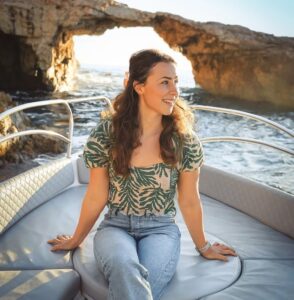 that large boats can’t reach
that large boats can’t reach -
The ability to anchor away from the crowds, even in the Blue Lagoon
-
A quieter, more peaceful atmosphere that matches the island’s spirit
-
Flexible departure times from Malta or Gozo, tailored to your day
It’s the difference between being herded around — or having a truly personal, immersive experience.
Avoid the Crowds, Protect the Island
When you book a private boat trip to Comino, you’re not only choosing comfort and exclusivity — you’re helping reduce the pressure on the island. Smaller groups mean less foot traffic, less noise, and less strain on local resources. It’s a win for the island, and a win for your day out.
As new rules are introduced — like the 2025 limit on commercial visitors and the upcoming ticketing system for those stepping on land — it’s more important than ever to plan your trip smartly.
Private charters are not affected by these restrictions, as they operate responsibly, in small groups, and with sustainability in mind. Plus, you still get full access to swim, snorkel, and explore — but in the clearest waters, away from the busiest spots.
Outdoor Explorers Malta: Your Trusted Local Operator
At Outdoor Explorers Malta, we specialize in private boat charters to Comino, Cominotto, and the Blue Lagoon. We’re a small, family-run company based in Malta that believes in real experiences — not rushed sightseeing.
Our modern speedboats are safe, fast, and comfortable. We know the island better than anyone and we’ll take you to the quietest areas of the Blue Lagoon, the most stunning swimming caves in Crystal Lagoon, and those peaceful corners that day cruises never reach.
We also offer boat rentals, jetski tours, and flexible itineraries designed around what you want to see — not what’s on a brochure.
If you’re looking for a Malta private boat tour that puts nature, comfort, and privacy first — we’d love to welcome you aboard.
Ready to See Comino the Way It Should Be?
Let Comino surprise you — not just with its famous waters, but with its hidden history, its silent bays, and its untouched charm. Choose a way to visit that respects the island and rewards you with an experience unlike any other.
Book your private boat trip to Comino and Cominotto with us and discover the real magic — away from the crowds, and deep into the story.

